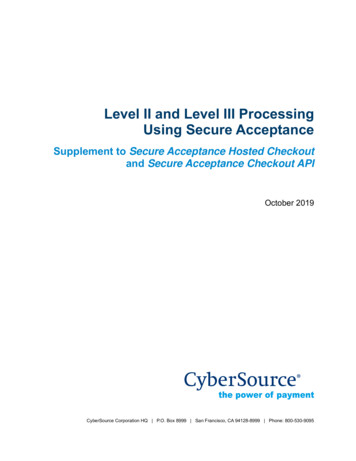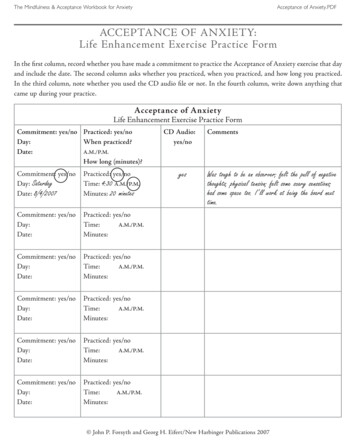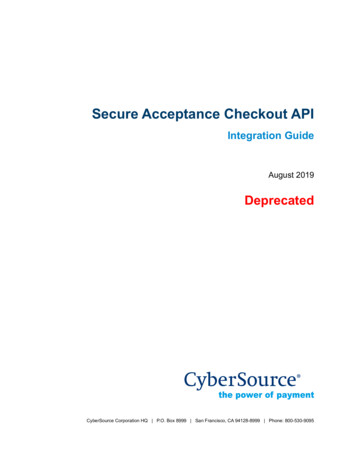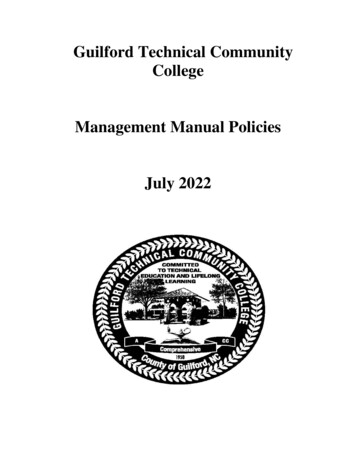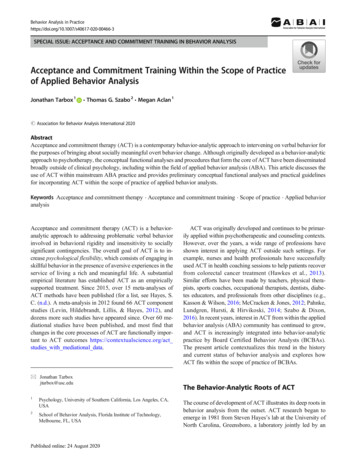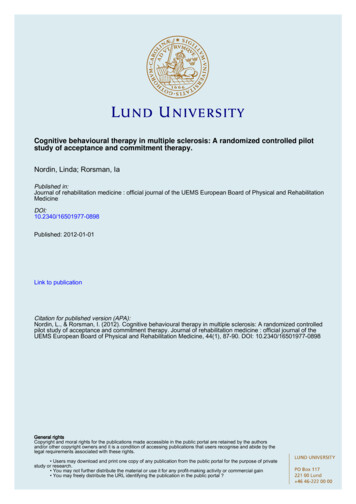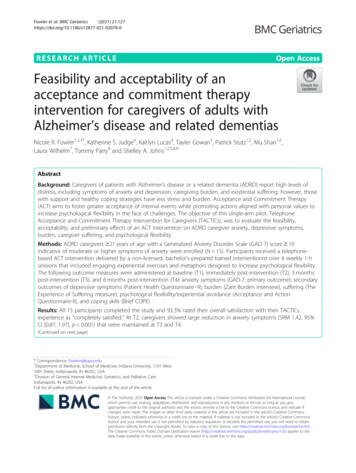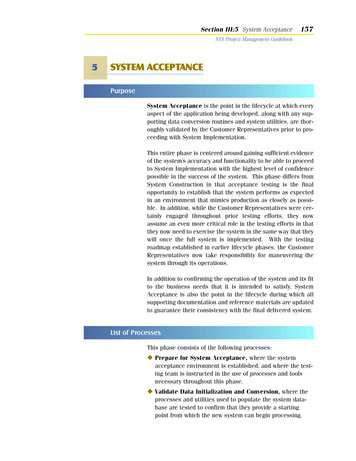
Transcription
Section III:5 System Acceptance157NYS Project Management Guidebook5SYSTEM ACCEPTANCEPurposeSystem Acceptance is the point in the lifecycle at which everyaspect of the application being developed, along with any supporting data conversion routines and system utilities, are thoroughly validated by the Customer Representatives prior to proceeding with System Implementation.This entire phase is centered around gaining sufficient evidenceof the system’s accuracy and functionality to be able to proceedto System Implementation with the highest level of confidencepossible in the success of the system. This phase differs fromSystem Construction in that acceptance testing is the finalopportunity to establish that the system performs as expectedin an environment that mimics production as closely as possible. In addition, while the Customer Representatives were certainly engaged throughout prior testing efforts, they nowassume an even more critical role in the testing efforts in thatthey now need to exercise the system in the same way that theywill once the full system is implemented. With the testingroadmap established in earlier lifecycle phases, the CustomerRepresentatives now take responsibility for maneuvering thesystem through its operations.In addition to confirming the operation of the system and its fitto the business needs that it is intended to satisfy, SystemAcceptance is also the point in the lifecycle during which allsupporting documentation and reference materials are updatedto guarantee their consistency with the final delivered system.List of ProcessesThis phase consists of the following processes: Prepare for System Acceptance, where the systemacceptance environment is established, and where the testing team is instructed in the use of processes and toolsnecessary throughout this phase. Validate Data Initialization and Conversion, where theprocesses and utilities used to populate the system database are tested to confirm that they provide a startingpoint from which the new system can begin processing.
158Section III:5 System AcceptanceNYS Project Management Guidebook Test, Identify, Evaluate, React (TIER), where the systemfunctions and processes undergo a series of exhaustiveacceptance tests to validate their performance to specifications, and where examination of test results determineswhether the system is ready to begin production. Refine Supporting Materials, where the various materials that support the use, operation, and maintenance of thesystem are updated to reflect any necessary adjustmentsresulting from acceptance test results.The following chart illustrates all of the processes and deliverables of this phase in the context of the system developmentlifecycle.
Section III:5 System Acceptance159NYS Project Management GuidebookFigure 5-1System ConstructionSystem AcceptancePrepare forSystemConstructionSystem ImplementationPrepare forSystemImplementationPrepare emRefined SystemStandardsValidateData Initializationand ConversionBuild, TestandValidate(BTV)ConductIntegration andSystem TestingProduceUser andTrainingMaterialsDataValidationResultsUnit TestResultsIntegrationand SystemTest eTestResultsUser MaterialsTraining DocumentationTechnicalDocumentationRevised User/Training MaterialsRevised TechnicalDocumentationTransition toPerformingOrganization
160Section III:5 System AcceptanceNYS Project Management GuidebookList of RolesThe following roles are involved in carrying out the processesof this phase. Detailed descriptions of these roles can be foundin the Introductions to Sections I and III. Project Manager Project Sponsor Business Analyst Data/Process Modeler Technical Lead/Architect Application Developers Technical Writer Software Quality Assurance (SQA) Lead Technical Services (HW/SW, LAN/WAN, TelCom) Information Security Officer (ISO) Technical Support (Help Desk, Documentation, Trainers) Customer Decision-Maker Customer Representative Stakeholders
Section III:5 System Acceptance161NYS Project Management GuidebookList of DeliverablesThe following table lists all System Acceptance processes, sometechniques available for use in executing these processes, andprocess outcomes and deliverables.Figure 5-2ProcessesTechniquesProcess Deliverables(Outcomes)Prepare for SystemAcceptanceInterviewsSite Walk-throughsEnvironmental AssessmentsAcceptance Test Plan ReviewEstablished Team andEnvironment forSystem AcceptanceValidate DataInitialization andConversionManual TestingAutomated TestingDefect TrackingRegression TestingData Validation Test ResultsValidated Data Initializationand Conversion SoftwareTest, Identify,Evaluate, React(TIER)Manual TestingAutomated TestingDefect TrackingRegression TestingAcceptance Test ResultsValidated SystemValidated System UtilitiesRefine SupportingMaterialsTechnical WritingIllustrationOn-line Content DevelopmentContent ReviewRevised User/TrainingMaterialsRevised TechnicalDocumentation
162Section III:5 System AcceptanceNYS Project Management Guidebook5.1PREPARE FOR SYSTEM ACCEPTANCEPurposeThe purpose of Prepare for System Acceptance is to ensurethat the testing environment to be used during SystemAcceptance is ready and operational, and to take any stepsneeded to prepare the acceptance testing team to successfullyachieve their testing goals.DescriptionThis phase of the SDLC is significant because it is the last timethat rigorous testing will be performed on the system before itgoes into production. It is also very likely the first time thatCustomer Representatives will be able to exercise the application in a near-production environment, which adds a uniqueRolesperspective to the testingefforts. Project ManagerPreparation of both the testersand the environment in whichthey will operate is crucial tothe success of this phase.User and training materialsmust be distributed in advanceof this effort, and any trainingsessions needed to familiarizethe testers with the application must be conducted. Project Sponsor Business Analyst Data/Process Modeler Technical Lead/Architect Application Developer SQA Lead Technical Services Information Security Officer Technical Support Customer Decision-Maker Customer Representative StakeholdersIn an ideal situation, those participating in the testing should receive the exact trainingand materials intended for Consumers, so that the usefulness and acceptability of thematerials can be validated.
Section III:5 System Acceptance163NYS Project Management GuidebookIn addition to familiarizing the testing team with the system,preparatory efforts must clarify for the team all testing rolesand responsibilities, the timeline allocated to these efforts, andall processes to be followed regarding recording of testingresults and reporting of defects. Although prior testing activities should have included Customer Representatives as part ofthe test team, it is common for this team to include anincreased number of representatives so that real productionoperations can be better emulated. As a result, the testingteam may now consist of participants who may not be as accustomed to rigorous testing activities as were members of theintegration and system testing team, who typically have a moresystems-oriented background. Therefore, expectations of theseindividuals need to be clearly defined, as do such elements asthe testing strategy to be followed, the extent of testing to beperformed, the definition of acceptance, etc.Preparation of the environment in which acceptance testing willbe performed is primarily focused on confirming that it is asclose to the production environment as possible and on migrating the application from the QA to the Acceptance environment.5.2VALIDATE DATA INITIALIZATION AND CONVERSIONPurposeThe purpose of the Validate Data Initialization and Conversion process is to confirm before the system begins productionthat all utilities and processes needed to load data into the system work correctly, and that any data carried forward fromanother system is migrated completely and accurately.DescriptionAs important as it is to ensure that the new application functions properly, it is equally important to ensure the accuracy ofthe data being processed by the system. This effort starts withthe initial loading of data, also known as “Day 1” data. The datais most often populated using two main methods – the manualloading of information required by the new system that cannotbe extracted or obtained from an existing system, and the automated loading of information currently available in one or moreexisting data sources.
164Section III:5 System AcceptanceNYS Project Management GuidebookRoles Project Manager Project Sponsor Business Analyst Data/Process Modeler Technical Lead/Architect Application Developer SQA Lead Technical Services Information Security Officer Technical Support Customer Decision-Maker Customer Representative StakeholdersThe acceptance testing team must exercise allaspects of the data initialization and loading ofinformation into the system database. Testing ofthe data load should be conducted very much likethe testing of the application itself, with all participants capturing the test results and identifyingany defects. The goal is to determine whether thequality of the data load process and the resultingdata are sufficient to proceed with implementingthe system. Any data problems that jeopardizethe eventual success of the system clearly need tobe addressed. It may be perfectly acceptable,however, to advance into further application testing activities with a known set of low-impact dataproblems, as long as the impact of these defectson subsequent testing efforts is understood inadvance, along with a defined timeframe by whichthe errors need to be corrected.The key difference between acceptance testing activities and all prior testing efforts isthat while it was reasonable to expect iterative testing cycles in earlier phases, the goalof acceptance is to demonstrate that the deployment and use of the system will be successfulin a production-like setting. Therefore, whether validating data initialization efforts or specificsystem functions (as described in the following process), all activities performed in this phaseshould already have been successfully demonstrated in System Construction, albeit in a slightly different environment.This does not mean that that there won’t be decision points throughout this phase at whichtest results will need to be evaluated, usually as part of an overall set of test results, to determine the proper course of action. Once these test results are in hand, then an informed decision can be made to either move ahead with continued testing, or to address known issues asthey are discovered, only moving forward when the error condition has been corrected.Deliverable Data Validation Test Results – A comprehensive set ofcompleted test plans identifying all data initialization andconversion tests that were performed, along with thedetailed outcomes of these tests, the list of defects identifiedas a result of these tests, and the results of any subsequentretests. These test results are contained in the AcceptanceTest Plan section of the Technical Specifications.
Section III:5 System Acceptance165NYS Project Management Guidebook5.3TEST, IDENTIFY, EVALUATE, REACT (TIER)PurposeThe purpose of the Test, Identify, Evaluate, and Reactprocess is to execute a complete suite of tests against theapplication in a production-like environment, assess the resultsof the tests, and determine whether it is appropriate to proceedwith System Implementation, or whether corrective actions arerequired to address any defects encountered.DescriptionRoles Project Manager Project Sponsor Business Analyst Data/Process Modeler Technical Lead/Architect Application Developer SQA Lead Technical Services Information Security Officer Technical SupportThis process is analogous in many ways to theConduct Integration and System Testing processin System Construction. While the primary responsibility for conducting the testing has movedfrom the Application Developers to the CustomerRepresentatives, many of the principles thatapplied to earlier testing efforts apply here aswell. The need for capturing testing metricsremains essential for conducting quality assurance practices, and the adherence to rigorousconfiguration management and release migration procedures remains crucial to understanding exactly which versions of the software arebeing tested at any given time. Customer Decision-Maker Customer Representative StakeholdersBecause the Customer is anxious to implement the new system and restore testing personnel to their primary business functions, acceptance testing tasks are often underemphasized. Thorough testing procedures cannot be stressed strongly enough. Failure to perform these tasks with high quality and attention to detail could cause serious problems in thefuture, perhaps after the system has been placed into production. Time invested at this stagewill save time overall.
166Section III:5 System AcceptanceNYS Project Management GuidebookThroughout this process, any problems identified by the testersmust be recorded and tracked to closure on defect logs.Continual interaction is essential between those doing the testing and those who developed the application. The ProjectManager must closely manage the activities in order to ensureadherence to the Project Scope and Schedule.Another factor to consider during this process is that organizations may choose to perform parallel operations during acceptance testing. This requires a continuation of existing businessprocesses at the same time that the new system is being tested. This may mean that while transactions are entered into thenew system, they will also need to be entered separately intoany existing legacy systems, or may need to be captured inwhatever manual systems are currently being utilized. Thisoften requires additional staff or extra hours in order to keepup with the additional workload, but allows the results of thetwo processes to be compared for accuracy. If this parallelapproach is taken, the extra burden on the PerformingOrganization will need to be estimated and communicated tothe Stakeholders so that they can make an informed decisionregarding any additional costs, the duration for which theorganization can sustain these costs, and the benefits resultingfrom this approach.Regardless of whether or not parallel operations are planned,the recommended approach for testing applications is to drivea time-boxed set of coordinated tests that adhere to the TIERapproach, as follows:Test: Following the initialization of the Acceptance environment, acceptance testing will occur, during which all perceiveddefects in the application are recorded. The exact frequencywith which these defects are reported will vary with each project – the important point to note here is that communication ofthese defects needs to be constant throughout the testing toavoid the ‘big bang’ effect that can occur when all issues arereported only upon completion of the testing.Identify: The Project Manager will engage the appropriateteam members to analyze each reported defect to determinethe cause of the defect being reported, and to identify whetheror not a true system error has been encountered. While defectsare often related to adjustments needed in the application software, it is equally possible that the root cause of a reported
Section III:5 System Acceptance167NYS Project Management Guidebookdefect is the tester’s misunderstanding of exactly how the system was designed to operate. Changes to normal businessoperations due to new functionality, combined with the revisedlook and feel of the application, often result in system errorsbeing reported that in fact are examples of the system workingexactly as designed.The Project Manager should keep in mind that system errors or defects may be reported that result more from a misinterpretation of expected functionality as opposed to atechnical defect. Even though the system may be operating exactly as defined, this scenariomay point to other non-technical errors associated with the system. It may be possible that theon-line help system may not sufficiently describe the system’s operations, or that a componentof the overall training package may require an increased level of detail in one or more areas.Take advantage of System Acceptance to evaluate the entire system and its supporting materials, and make adjustments now while you can still get out in front of the final implementation.Evaluate: If a defect in the application is identified, the ProjectTeam will work together to identify the appropriate correctiveaction. A decision will be made regarding whether or not system modifications are required, whether data loaded in theprior process needs to be corrected, whether operational procedures need to be adjusted, or whether some other form ofcorrection is required. Once a corrective action is identified, itwill then be prioritized, along with all other on-going activities,to determine if this issue is of sufficient impact to warrantadjustments being made during System Acceptance. Since alltesting efforts should adhere to the Project Schedule, theunderlying question becomes, “Can the system be placed intoproduction with the existence of this condition, or is its impactsuch that implementation of the system is not possible due toinability to perform essential business operations”? If anacceptable work-around exists, or if the impact is minimal,then a determination can be made to handle the correction aspart of a normal production support issue once the system isimplemented.React: Once the appropriate actions and priorities have beenidentified, the defect will be resolved. For those defects requiring changes to the application, the appropriate changes shouldbe made, tested, and re-released to the Customer Representa-
168Section III:5 System AcceptanceNYS Project Management Guidebooktives for validation. For all other defects, the agreed-to resolution should be communicated to all parties.The key to successful completion of System Acceptance is theclear definition of go/no-go criteria that can be used to definethe set of circumstances that would preclude placing the application into production. Should a “show stopper” be identified inthese final days of testing, the Project Team must estimate andplan the appropriate corrective actions and retesting needed toresolve the problem, and then adjust the testing scheduleaccordingly using the standard Project Change procedures.However, if the list of issues at the end of acceptance testingcontains only low priority, low impact modifications, (i.e., thosethat do not significantly inhibit the use of the application), testing can be considered complete. At this point, the projectshould progress to the next phase, with all remaining issuesaddressed through the application support mechanisms.Deliverable Acceptance Test Results – A comprehensive set of completed test plans identifying all acceptance tests that wereperformed, along with the detailed outcomes of these tests,the list of defects identified as a result of these tests, andthe results of any subsequent retests. These test resultsare contained in the Acceptance Test Plan section of theTechnical Specifications.
nsitionalRequirementsImpactsOperations andSupportOperationalRequirementsImpacts s theBusinessProcessFunctionalRequirements Data Conversion System Testing Documentation Training Deployment System Performance Data Archival Audit and Controls System Administration SQA Business Continuity Accessibility Encryption Hosting Environment Disaster Recovery Common Functions GUI Functions Reporting Functions Interface Functions Batch Functions Security FunctionsTypical stemAcceptance Mechanism for migrating new releases into production. User and Training materials accurately reflect the application. Technical documentation is accurate.new system. Historical data cleansing, conversion, and import into the Data archival and recovery processes meet expectations.of the system. System responds in accordance with stated performance requirements. Administration functions support long-term maintenance and operation All accessibility requirements have been satisfied. System conforms to all regulatory requirements (e.g., HIPAA). All data is appropriately encrypted and/or protected. Functions satisfy business requirements and functional specifications. GUI is comprehensive, intuitive, and easily navigated. Information on reports matches corresponding data presented in GUI. Batch and periodic processes align with business requirements. Errors are handled consistently and informatively.Representative Functions To Be ValidatedSystemDesignSystem Development LifecycleFigure 5-3 System Acceptance ConsiderationsRefine SupportingMaterialsTest, Identify,Evaluate, and React(TIER)Validate DataInitialization andConversionPrepare forSystemAcceptanceSystemImplementationSection III:5 System Acceptance169NYS Project Management Guidebook
170Section III:5 System AcceptanceNYS Project Management Guidebook5.4REFINE SUPPORTING MATERIALSPurposeRefine Supporting Materials ensures that all materials relating to the new application are kept up-to-date with any changesthat may be introduced during System Acceptance.DescriptionRoles Project Manager Project Sponsor Business Analyst Data/Process Modeler Technical Lead/Architect Technical Writer SQA Lead Technical Services Information Security Officer Technical SupportDespite the best efforts of the Project Teamthroughout the earlier phases of the lifecycle, itis common for acceptance testing activities touncover issues that require changes to the application. In the best cases, these may be nothingmore than small cosmetic changes. In extremecases, defects detected during testing couldresult in major subsystems of the applicationbeing redesigned and rewritten. Regard- less ofthe situation, all supporting materials, (bothConsumer- and Technical Support-oriented),should be reviewed to make sure that they stillaccurately reflect the system that will bedeployed in System Implementation. Customer Decision-Maker Customer Representative StakeholdersDeliverables Revised User/Training Materials – An updated set ofmaterials aimed at assisting Consumers with the use andoperation of the application, reflecting any changes thatwere introduced as a result of acceptance testing efforts. Revised Technical Documentation – A corresponding setof updated technical materials, again reflecting anychanges introduced as a result of acceptance testingefforts and defining aspects of the application that will beuseful to those individuals responsible for on-going systemmaintenance.
Section III:5 System Acceptance171NYS Project Management GuidebookMeasurements of SuccessThe ultimate measurement of success for System Acceptance isthe agreement by the Customer to move the system into production.Meanwhile, the Project Manager can still assess how successfully the project is proceeding by utilizing the measurement criteria outlined below. More than one “No” answer indicates aserious risk to the eventual success of the project.Figure 5-4ProcessPrepare for SystemAcceptanceMeasurements of SuccessDo you have the commitment from CustomerDecision-Makers to make the right people availableto the extent necessary for the duration of Acceptanceactivities?Does your testing community agree that they areadequately prepared for the Acceptance activities?Does everyone have access to and the correctsecurity level for the system?Validate DataInitialization andConversionCan you say with confidence when each outstandingdata initialization and conversion defect in the logwill be corrected?Do your Customers agree with your assessment?Test, Identify, Evaluate,and React (TIER)Can the developers fixing the defects determine,based on the defect log and test results, what theproblem scenario was and what outcome wasexpected vs. what was experienced?Are retesting efforts demonstrating that reporteddefects are being resolved with new releases, andthat the same issues are not being reported fromiteration to iteration?Refine User andTraining MaterialsHave you made changes to the user/trainingmaterials as a result of your experiences in usertraining and acceptance testing in this phase?Have you made changes to the TechnicalDocumentation as a result of its review by arepresentative of the group that will assumeresponsibility for the system once it’s deployed?YesNo
172Section III:5 System AcceptanceNYS Project Management GuidebookPhase Risks / Ways to Avoid PitfallsPITFALL #1 – YOU EXPECT ME TO DO WHAT?The long Construction cycle is finally over. The system is pretty much done. Your team knocked itself out delivering whatwas promised, on time, within budget. You can hardly curb yourenthusiasm as you call the Customer Decision-Maker to invitehis cohort to spend a few weeks in the trenches slugging it outwith the remaining system bugs. Curiously, all you get is deadsilence, followed by a string of strangely unintelligible exclamations. Oops!Customers (and Consumers), especially ones not experiencedwith formal system acceptance activities, assume that the newsystem will just materialize on their desktops, free of defectsand perfect in every way. They view it the same way they viewshrink-wrapped software packages, and have no idea how mucheffort goes into getting the system to the turnkey stage. It is agreat shock for them to learn that, in addition to letting the system developers know what they wanted at the beginning, theyneed to verify at the end that what the developers actuallydeveloped meets their expectations.Since the acceptance activities are fairly rigorous and protracted, it behooves an astute Project Manager to set those expectations way up front. Disarm them with the intention of making sure they got what they asked for, detail for them theacceptance activities and the expected level of participationand commitment, and keep reminding them, as SystemAcceptance nears, of their promises of people and time.PITFALL #2 – WHAT THEY WANT VS. WHAT THEY ASKED FOROK, you avoided the pitfall #1 above, and an eager and agreeable group of Customers traipsed over to your neck of thewoods to try out the new system. However, the honeymoon isover real quick when they actually try out the new functions.Between System Requirements Analysis and SystemAcceptance, time has passed, things changed and peoplemoved around, and now nobody remembers who wanted whatand why; they just know that what they see is not somethingthey want to get.
Section III:5 System Acceptance173NYS Project Management GuidebookOne of the hardest things to manage during the system development lifecycle is expectations. Keeping a good audit trailshould help. How good were your deliverable definitions? Howtight were your acceptance criteria? Were those deliverableapproval signatures written in blood – or water?The answers to these questions spell a difference betweenorderly change control, and unmitigated disaster.PITFALL #3 – FLOATING THE GARBAGE DOWNSTREAMFinally, you avoided both of the above pitfalls, and theCustomer Representatives are oohing and aahing about the system design until they actually try to DO something. Then, allheck breaks loose: the navigation is off, the business logic isfaulty, the system crashes, and the dreaded hourglass justkeeps flipping over and over and over and over endlessly until the Customers see red behind the Blue Screenof Death. It is obvious that the system was not tested properly, and the Customers naturally resent it. Nasty rumors beginto spread, and instead of the welcome mat, the Consumersready tar and feathers for the system deployment ceremonies.In the heat of the construction homestretch, the temptation isto take short-cuts assuming any problems can be fixed downstream: cutting corners on software quality assurance at theunit test level, hoping to make it up during integration testing;skipping functionality reviews, hoping that the Customers willcatch the errors during acceptance testing; even short-shriftingthe initial training, hoping to make up for it duringImplementation.The problem is, there is never enough time in subsequent phases either. Plus, the expectations have not been set up. So ifyou float the consequences of bad decisions downstream, you’lljust have a bigger pile of trash to deal with, instead of unfurling your sails and parading across the finish line.
174Section III:5 System AcceptanceNYS Project Management GuidebookPITFALL #4 – “IT’S TOO LATE, BABY!”Another consequence of trying to short-cut the processupstream and hoping to make it up downstream is that a pointcomes when it’s too late to address some issues. In SystemAcceptance, it’s too late to fix system performance problems.It’s too late to correct data conversion routines. It’s too late toredefine core functionality, and it may even be too late to introduce minimal business process changes.Problems like that cannot be fixed in this phase. If you can’tavoid them, what you need to do is go back, and loop the lifecycle over. For data conversion problems, you probably need togo back to Construction. For performance problems, to Design.And as for problems with core functionality (with apologies toCarole King) – “Something inside has died” and you’d betterpush the old STOP button and rewind to the beginning; then,maybe, “there will be good times again.”PITFALL #5 – PLAYING THE BLAME GAMEWhen the Customer is unhappy with t
Section III:5 System Acceptance 157 NYS Project Management Guidebook 5 SYSTEM ACCEPTANCE Purpose System Acceptance is the point in the lifecycle at which every aspect of the application being developed, along with any sup-porting data conversion routines and system utilities, are thor-oughly validated by the Customer Representatives prior to pro-
